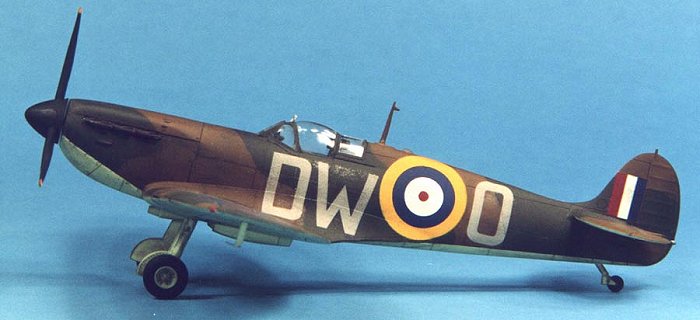
Tamiya 1/48 Spitfire I
|
KIT # |
61032 |
|
PRICE: |
$26.98 |
|
DECALS: |
2 Options |
|
REVIEW & |
|
|
NOTES: |

|
HISTORY |
PHASE 2: "Adlerangriffe"—Destruction of the RAF
(Go here for the earlier
entry).
Poor weather on 10 August forced the postponement of "Adlertag" for 24 hours, and was later rescheduled by Goering to 13 August. There was no significant activity on the 10th, but aerial activity was high on the 11th. A bombing raid on Dover started the day, followed by three Luftwaffe fighter sweeps but the RAF generally did not pursue combat. Later in the day, a large German force of over 160 aircraft assembled for an attack on Portland that was engaged by approximately 70 British fighters. Heavy fighting ensued and many aircraft were lost on both sides; 27 by the RAF, and 36 Luftwaffe. In addition, convoy attacks were attempted in the Thames Estuary and the English Channel, but worsening weather stopped further action by the RAF.
Heavy activity was again observed on 12 August, with the morning started off by the now customary German fighter sweep, followed by a surprising attack on the British coastal radar chain. Some minor convoy attacks were also observed, but around noon, a German aerial force of over 200 aircraft was detected and approximately 58 RAF fighters were scrambled to oppose it. The German formation split into two groups; one attacking Portsmouth and the other attacking the radar station at Ventnor that was seriously damaged in the attack. Aerial casualties were high on both sides. In the afternoon, an attack of the RAF fighter bases at Manston, Lympne, and Hawkinge was accomplished; the first time British mainland fighter airfields had been attacked by the Luftwaffe. Casualties were high on this day, with 22 RAF aircraft lost and 31 Luftwaffe.
Poor weather and confusion reigned supreme on "Adlertag" morning on 13 August. Due to the deteriorating weather, the attack was postponed until later in the day but the word did not reach many German units who launched their attacks. Attacks were attempted on the naval base at Sheerness, and airfields at Eastchurch, Odiham, and Farnborough, but success on both sides was poor due to the weather. Such was not the case in the afternoon when the weather cleared.
The largest German aerial armada to date of over 300 aircraft was assembled in the afternoon to attack the docks at Southampton, the naval base at Portland, airfields at Andover, Detling, and Middle Wallop, and factories at Rochester. The RAF intercepted these attacks and heavy fighting ensued. Surprisingly the RAF suffered only 13 aircraft lost to the Luftwaffe’s 34. More importantly for the RAF, only three pilots were killed with two wounded, leaving many pilots to continue the battle. After darkness fell, the night attacks continued with German bombers striking throughout the mainland, even ranging as far as Belfast.
Fortunately, poor weather limited operations on the 14th, giving both sides a break from the intense fighting of the previous days. However, attacks were mounted by the Luftwaffe with a loss of 19 aircraft.
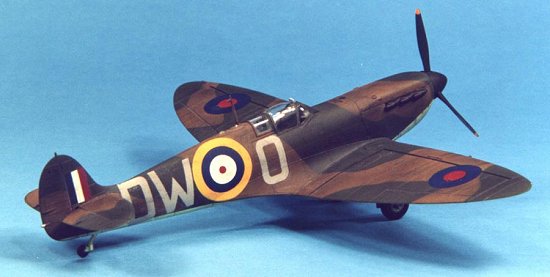 The weather on the
morning of 15 August was poor and forced the cancellation of many planned
missions. However, a rapid improvement in the weather later in the morning
allowed the planned operations to commence into what became the bloodiest day in
Luftwaffe history and a turning point in the BoB. JU87’s attacking Hawkinge
and Lympne accomplished the first attacks of the day, and the radar stations at
Dover, Rye, and Foreness with heavy damage. British Spitfires rose to defend but
were simply overwhelmed by the more numerous BF109 escorts. Shortly after noon,
a large bomber raid featuring the first major attack of HE111 bombers from
Norway struck the Newcastle area followed by JU88 bombers from Denmark. Little
damage was done in the raid, but the bombers were intercepted by British
fighters well out to sea and heavy German losses occurred. The Norwegian based
bombers never again attempted Mass daylight raids.
The weather on the
morning of 15 August was poor and forced the cancellation of many planned
missions. However, a rapid improvement in the weather later in the morning
allowed the planned operations to commence into what became the bloodiest day in
Luftwaffe history and a turning point in the BoB. JU87’s attacking Hawkinge
and Lympne accomplished the first attacks of the day, and the radar stations at
Dover, Rye, and Foreness with heavy damage. British Spitfires rose to defend but
were simply overwhelmed by the more numerous BF109 escorts. Shortly after noon,
a large bomber raid featuring the first major attack of HE111 bombers from
Norway struck the Newcastle area followed by JU88 bombers from Denmark. Little
damage was done in the raid, but the bombers were intercepted by British
fighters well out to sea and heavy German losses occurred. The Norwegian based
bombers never again attempted Mass daylight raids.
The afternoon of the 15th saw action return to southern England when the Germans launched a fighter-bomber raid on Martlesham Heath airfield followed by a JU88 raid on Rochester and Eastchurch. Both raids were heavily escorted by BF109’s and the British fighters rose in strength to oppose the attack and fighting was heavy. Slightly further to the west, a large strike force of JU88 bombers escorted by BF110’s attacked airfields at Middle Wallop, Odiham, and Worthy Down. Again, these formations were intercepted by the British with heavy aerial fighting. Still further to the west, a large bomber force comprised of JU87 dive-bombers and escorted by large numbers of BF109 and BF110 fighters struck the Portland area. Here, the British fighters were particularly effective against the Stuka’s and they suffered tremendous losses. Later in the afternoon fighting continued when the Luftwaffe fighter-bombers and JU88 bombers hit Croyden and West Malling airfields. The heaviest fighting in the BoB occurred on 15 August with the Luftwaffe losing an astounding 75 aircraft in 2,199 sorties and the day became known as "Bloody Thursday". The RAF also suffered heavily losing 30 aircraft in 974 sorties.
Combat continued on 16 August, although at a much reduced level after the all out attacks on the 15th. Airfields were the primary targets of the Luftwaffe with West Maling, Tangmere, Westhampnet, Manston, Farnborough, Harwell, Brize Norton, Gosport, and Lee-on-Solent all being hit. In addition, the radar station at Ventnor was also successfully attacked. Losses this day were also heavy, with the RAF losing 22 aircraft and the Luftwaffe 45 aircraft.
After a much needed day off from combat on the 17th, intense activity resumed on 18 August. Action started around noon, when heavy attacks were underway on the sector stations at Kenley and Biggin Hill. The airfields at Croyden and Manston were also hit. Along the coast, a large attack led by JU87 bombers hit the airfields at Thorney Island, Gosport, and Ford. In addition, the radar station at Poling was also hit. The Luftwaffe took large casualties on the day, primarily the JU87 and BF110, which lost 18 and 17 aircraft respectively. This forced the removal of the JU87 from the battle, and BF110 operations were severely restricted. A total of 31 RAF aircraft and 53 Luftwaffe aircraft were lost in the day.
A combination of poor weather and a needed respite from operations led to low levels of combat until 24 August. The Luftwaffe hit airfields at Manston, Hornchurch, and North Weald, but the most significant activity of the day was when bombs intended for Thames Haven and Rochester were dropped over central London. This accident would have a far-reaching effect on the battle yet to come. A total of 22 RAF and 38 Luftwaffe aircraft were lost on the day.
Combat activity continued on the 25th, however the events of the day were overshadowed by the RAF Bomber Command attack on Berlin at night in retaliation for the bombing of London the previous day. While not planned as such, this attack was to have a profound effect on the remaining battle in which the Luftwaffe changed their attack strategy from decimating the RAF to attacks on London. At this time the Luftwaffe was very close to defeating the RAF and the respite from the almost continual attacks on RAF airfields was much needed.
Combat activity remained relatively high through the remainder of August, with the RAF losing 132 aircraft and the Luftwaffe losing 168 aircraft in the final week.
The first week in September saw continued Luftwaffe attacks on the RAF bases and also a new emphasis on the aircraft manufacturing facilities. The attacks were not as massive as those in mid-August, but casualties remained significant for both sides with the RAF losing 120 and the Luftwaffe losing 143 aircraft for the first six days of the month. However, the battle was going to change significantly on 7 September.
PHASE 3: "Blitzkrieg on London"
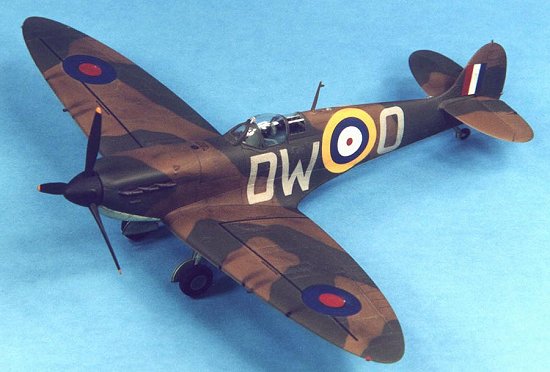 7 September dawned
fairly quiet, a few reconnaissance patrols but no significant air activity.
However that was all to change by the late afternoon when the Luftwaffe launched
an assault force of about 350 bombers escorted by about 600 fighters. British
fighters were scrambled to intercept, but expecting continued attacks on the RAF
airfields they left London largely unguarded. By the time the RAF had realized
that the target was indeed London and vectored their fighters towards the
bombers, most of the German bombing runs were over. The result was horrific;
London was in flames. Four hours later during the night, the Luftwaffe assembled
another attack striking London. Guided by the roaring fires, the German bombers
once again found London as the target. No respite would be given for the next
seven days, London would be bombed heavily each night.
7 September dawned
fairly quiet, a few reconnaissance patrols but no significant air activity.
However that was all to change by the late afternoon when the Luftwaffe launched
an assault force of about 350 bombers escorted by about 600 fighters. British
fighters were scrambled to intercept, but expecting continued attacks on the RAF
airfields they left London largely unguarded. By the time the RAF had realized
that the target was indeed London and vectored their fighters towards the
bombers, most of the German bombing runs were over. The result was horrific;
London was in flames. Four hours later during the night, the Luftwaffe assembled
another attack striking London. Guided by the roaring fires, the German bombers
once again found London as the target. No respite would be given for the next
seven days, London would be bombed heavily each night.
15 September, which would go down later in history as "Battle of Britain Day", saw the daylight attacks on London resume. However, Fighter Command had the respite it needed from the relentless attacks on its facilities to rebuild and redeploy to prepare for this attack on London. When the Luftwaffe launched their major attack on London around 11:00 AM, the British fighters were ready and met the German assault head-on. Massive dogfights ensued, and by the time the bomber force reached London, the bombers were largely devoid of their fighter escorts. The German bombers then received their first introduction to the "Big Wing", five squadrons of British fighters led by the famous Douglas Bader. Together with other British units, the "Big Wing" feasted on the bombers causing them to jettison their bombs haphazardly spoiling their bombing runs. Shortly after noon, the German bomber force was retreating back to France and hunted relentlessly by the British fighters. Two hours later the Luftwaffe tried another attack, but it too was met by massive British force and largely repelled. In terms of aircraft losses, the battle did not seem all that spectacular compared to the mid-August attacks, with the British losing 27 and the Luftwaffe losing 56 aircraft, but the tide had turned in the BoB. For the first time in the battle, the British had the advantage in strategic position in the air and were not significantly outnumbered. The Luftwaffe, on the other hand were severely disenchanted believing they had the British "on the ropes" only to see massive resistance.
On September 19, even though the British did not know it at the time, the BoB was won when the Germans cancelled Operation Sealion, the planned invasion of Britain. Although London was bombed relentlessly at night, only two days remaining in September featured large scale day fighting, on the 27th and 30th, although these raids were nowhere near the size featured earlier in the month.
PHASE 4: Day Attacks Cease
While night attacks would continue on London, and other important British industrial centers, October would feature an end to the massive day light raids seen earlier. However, a new German tactic of bombing raids by BF109 "Jabos" was started which were very difficult to defend against. The "Jabo" raids were more of a nuisance than an actual threat, but the BoB was all but over.
|
THE KIT |
Scott has recently completed an excellent review of this kit . I agree completely with everything he has written and can add nothing of any significance to his review except to expand the history section
|
PAINT, DECALS, & WEATHERING |
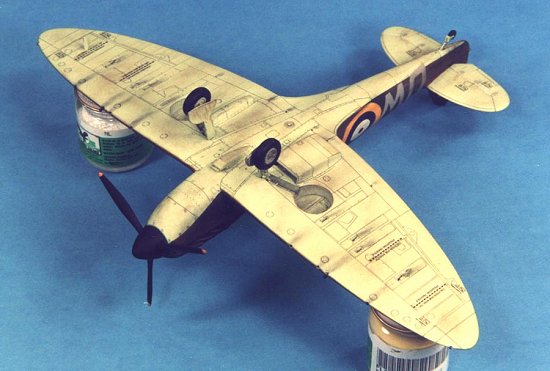 I chose to model the
aircraft flown by the British 610 Squadron. The aircraft is in the early British
day fighter scheme of dark green over dark earth with sky undersides. I used
Polly Scale acrylic paint throughout. After letting the paint dry overnight, I
airbrushed a light coat of Future to prepare the surface for decaling. The
decals went on quite well and responded to Microsol without any permanent
wrinkling. Some silvering was noted in the extensive clear areas surrounding the
squadron codes. After drying overnight, I wiped the decals off with a moist
cloth with Pollys Plastic Prep to remove any residue and after drying I shot a
light coat of Future over the decals to seal them.
I chose to model the
aircraft flown by the British 610 Squadron. The aircraft is in the early British
day fighter scheme of dark green over dark earth with sky undersides. I used
Polly Scale acrylic paint throughout. After letting the paint dry overnight, I
airbrushed a light coat of Future to prepare the surface for decaling. The
decals went on quite well and responded to Microsol without any permanent
wrinkling. Some silvering was noted in the extensive clear areas surrounding the
squadron codes. After drying overnight, I wiped the decals off with a moist
cloth with Pollys Plastic Prep to remove any residue and after drying I shot a
light coat of Future over the decals to seal them.
Next, a light coat of Polly S Flat Finish was shot to provide a surface for pastels. I used an engineering pencil sharpened to a fine point to highlight the panel lines. This gives a more subtle effect than my usual wash technique that I really liked, but it was a little more time consuming. I then used pastels applied with a soft brush to simulate the dirt staining that is commonly seen on these aircraft that were operated from grass fields. Lastly, I sealed everything with a light coat of Polly S Flat Finish.
|
CONCLUSIONS |
Tamiya models are my absolute favorite to build, as they usually have no major problems to contend with. This kit was no exception, and not a single spot of filler was needed. This kit makes a beginner modeler look like an expert and is highly recommended.
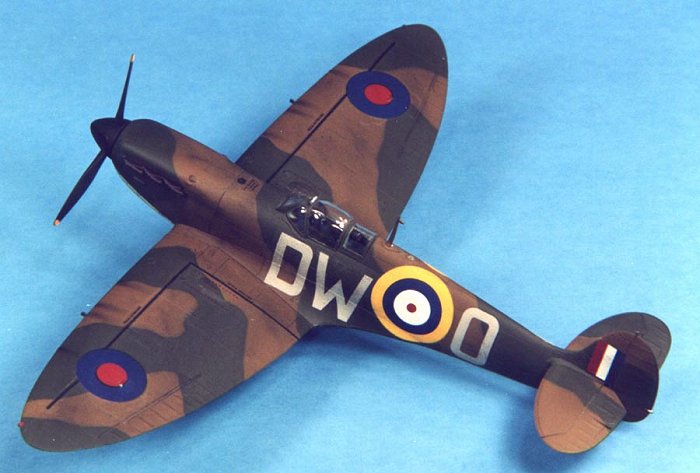
|
REFERENCES |
Squadron/Signal Publications, Spitfire in Action #39
Smithmark Publishers, The Battle of Britain
Review kit courtesy of me and my wallet!
If you would like your product reviewed fairly and fairly quickly, please contact the editor or see other details in the Note to Contributors.